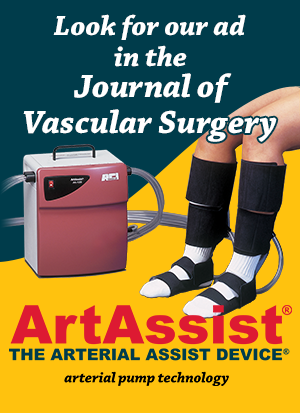Lorraine K. of Grand Forks, ND was diagnosed with severe PAD. For treatment, she at first received a calf-only pneumatic compression device from her hospital. After using this system for a week, she decided that the pressure was too weak and that she was unsatisfied.
Her doctor at the Mayo Clinic in Rochester, MN, then prescribed ArtAssist®…The Arterial Assist Device® for Lorraine in 2002. She was told to use it 4-6 hours a day. Later that year, Lorraine purchased our pump and began to use it in early 2003. She noticed an immediate difference, saying that ACI Medical’s arterial pump “blew [the calf-only system] out of the water.” Since her purchasing of the ArtAssist® device, Lorraine has sent it back to ACI Medical only once for repairs and uses it faithfully for the prescribed amount of time each day.
Lorraine’s only suggestion for the ACI Medical team is to “get the word out” about the therapy that has helped her so much. Sometimes, we receive thank you letters from Lorraine. So, in that spirit, here is a letter she wrote to Don Kjartanson, our Director of Sales & Marketing:
Dear Don,
I wish to thank you for all the good service you have given me, especially for the new blue cuffs, nice to have some color.
The Dr.’s of Rochester, MN have really been surprised to see how well I’ve been doing with my machine. That’s the only thing that keeps me going. I think I’m in the 11th year so am so happy to have found out about this machine. If anyone wants to write to me, I’ll be happy to hear.
Use my remarks as you wish.
And thanks so very much. I could not afford what you’ve given me.
Keep up the good work.
Sincerely,
Lorraine K.
Diana’s note: I hope you enjoyed reading Lorraine’s sweet note, because patients like her really put the cherry on top of the cake! Even though we already believe in ArtAssist® Arterial Pump Technology as a way to treat PAD, it’s a great feeling to hear from actual patients who need the device. And that, my friends, is what should drive a marketing department!
Update
Since the above entry was based on a telephone conversation and a greeting card, the customer service team at ACI Medical has been reaching out to patients who wish to share their stories. Since Lorraine always has something to add, we invited her to send us all of her thoughts. Among all of our patients, she is certainly one of the most informed about the ArtAssist® device, as she has been using it for almost 12 years! I hope you enjoy her account of how she went from fearing for her limbs to leading a happy, functional life in her own home.
Q: When it comes to ACI Medical’s customer service, what stands out to you?
To me it’s the very best, very good service. They have always treated me well, they take an interest in you.
Q: What would you say to a friend, who was looking for a non-surgical solution for PAD, about the ArtAssist® device?
I would say, go for it you have nothing to lose but the pain, it may take a while to get results, so give it time.
Q: Who prescribed the ArtAssist® device for you?
My son Alvin went to the libraryand got the Reader’s Digest. This is where I found the ArtAssist advertisement, so I contacted the company. They sent me information, and after reading about the ArtAssist machine I went ahead and ordered it. I am so glad we ran across this article. It’s great.
Further thoughts
In March 28, 1996, I had a history of lower peripheral arterial occlusive disease, which had been long standing. I had a left femoral below the knee popliteal bypass graft, which failed in 1999. I had critical lower extremity occlusive disease and was referred for medical treatment. Dr. has been following me since 2000 for this problem. I had severe bilateral peripheral arterial occlusive disease, right 4th toe ulcer to ischemia, in heels then corroded briuts (?) hypertension. I used antifungal cream, I would get pain in calves & feet at a distance of walking across the room, both lower extremities are equally involved. I was using the ArtAssist pump 3 times a day, 90 minutes each hour, it’s remarkable after 11 to 12 years period of no limb loss has ensued. I maintain my activities of daily living and household duties. I have my own house. My son who is disabled lives with me, which is a big help. Dr. says given my age I am doing remarkable with my disease status. I’m now 89, and still have my limbs.
The ArtAssist compression pump is a therapeutic product, a powerful therapy for increasing blood flow with patients effects are for better than any other and without side effects, this has a unique form of pneumatic compression to the patients with diabetic foot ulcers, intermittent claudication, rest pain or non-surgical candidates, have seen positive results with this new technology.
The ArtAssist is very easy to use and very reliable. I look forward to using it, the compression cuffs are durable and designed to last for months of therapy. I am very lucky to have found something that has helped me so much, and I still have my limbs, the medical Dr.’s did all they could and after I got the ArtAssist device, which they didn’t seem to know anything about this machine, but they were happy for me and that I’m doing so well with it. I always use it 3 times a day. It’s the best. You will never find anything better.
Lorraine K.
 treatment helps poor circulation with Dr. Paul van Bemmelen“.
treatment helps poor circulation with Dr. Paul van Bemmelen“.the heart and assist in the circulation work. But modern humans are typically not active enough. The ArtAssist® is essentially a strong massage device that people can use at home. It obtains the good effects of walking – that is, increased blood flow – without the bad effects of walking, such as the need for more oxygen in the leg muscles with more pain. Also, real walking can worsen the friction between the skin and the shoes, which causes problems in diabetes.










